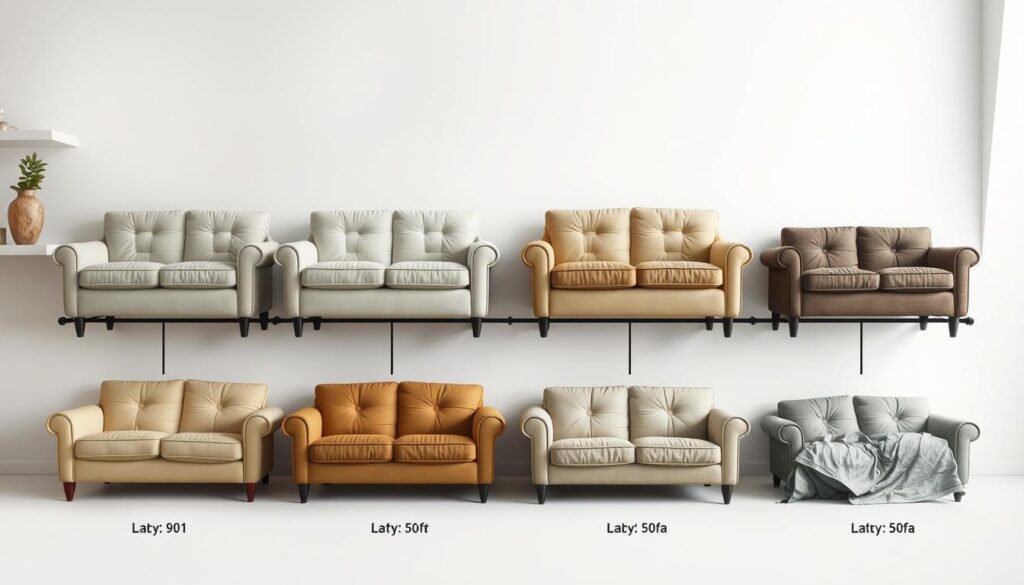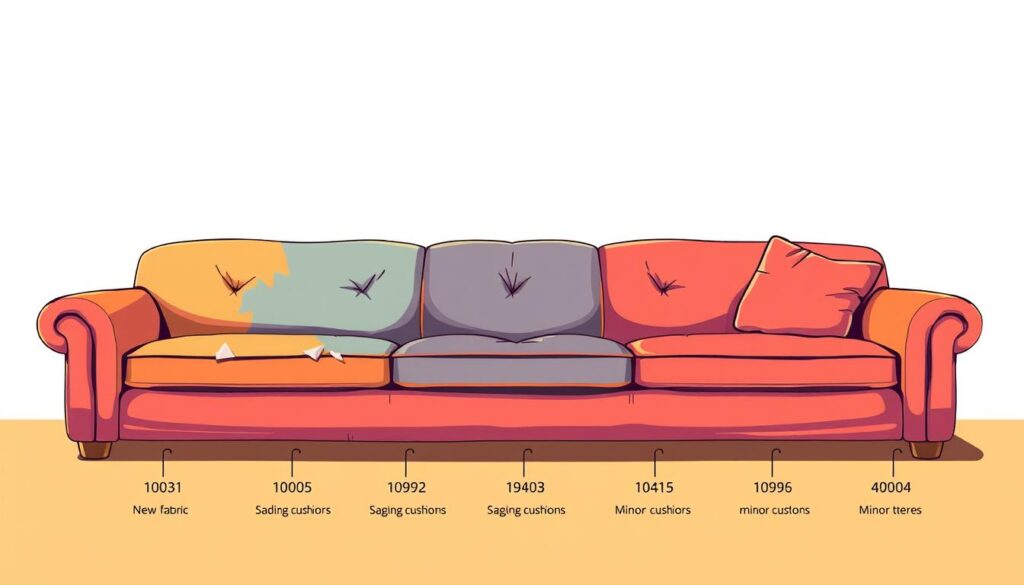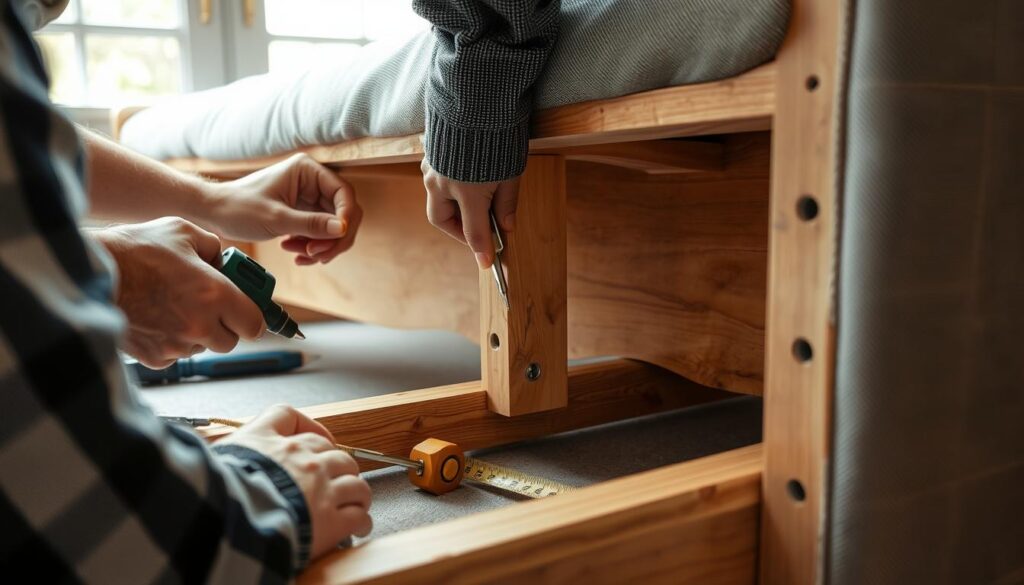Affiliate Disclosure
Sofa Insider Guy is a participant in the Amazon Services LLC Associates Program, an affiliate advertising program designed to provide a means for sites to earn advertising fees by advertising and linking to Amazon.
Ever thought about when your favorite sofa will need to be replaced? Many homeowners face this question, wanting to get the most from their furniture. But what really affects a sofa’s lifespan? Find out in this detailed guide on couch longevity.
Creating the perfect living room is an art, and your sofa is its heart. Whether you’re looking for a new couch or curious about your current one’s durability, knowing the average sofa lifespan is crucial. So, how long do sofas last, and how can you make yours last longer?

Key Takeaways
- The average sofa lifespan is 7 to 15 years, depending on quality and usage.
- Factors like frame construction, fabric quality, cushion design, and usage patterns affect a sofa’s longevity.
- Signs it’s time to replace a sofa include sagging cushions, structural damage, and worn upholstery.
- Proper maintenance, such as regular cleaning and cushion rotation, can extend a sofa’s lifespan.
- Investing in a quality sofa built with durable materials can provide up to 20 years of comfortable use.
Table of Contents
Factors Affecting Sofa Longevity
Several key factors affect your sofa’s lifespan. These include the sofa frame quality and fabric durability. Also, the cushion lifespan and sofa usage patterns play a role. Knowing these can help you choose wisely and keep your sofa looking great for years.
Frame Construction
The sofa’s frame is its backbone. The materials used can greatly affect its lifespan. High-quality wood frames, like hardwood or kiln-dried, can last over 15 years. On the other hand, cheaper wood or particleboard may not last as long.
Fabric Quality
The fabric durability of your sofa’s upholstery is key. Performance fabrics that resist stains and fading will last longer. This means your high-quality furniture will look good for years.
Cushion Design
The design and quality of your sofa’s cushions are important. Quality foam or down-filled cushions will keep their shape. This ensures your sofa stays comfortable and looks good.
Usage Patterns
The way you use your sofa also affects its lifespan. A sofa in a less used room will last longer. But a sofa in a busy room may not last as long.
Understanding these factors can help you choose the right sofa. This way, you can enjoy comfortable and stylish seating in your home for years.

Our Recommendation
Sleeper Sofa with Storage Chaise, Tufted L Shape Convertible Couch with 2 USB & Cup Holders, Dark Grey
Signs It’s Time to Replace Your Couch
Knowing when your sofa needs to be replaced is key to keeping your living space comfy and stylish. Sofas are built to last, but they won’t last forever. Spotting the signs that it’s time for a new couch helps you make a smart choice and avoid future problems.
Sagging Cushions
One clear sign your sofa is nearing the end is when the cushions start to sag. When you sit down and feel yourself sinking, it’s a sign the couch is losing its shape. This means it’s time to think about getting a new sofa.
Structural Damage
Another warning sign is when your sofa starts to creak or wobble. If the couch feels unstable or looks like it’s falling apart, it’s a sign of serious damage. At this point, the sofa may not be safe or comfy to use anymore.
Worn Upholstery
The state of your sofa’s upholstery is also a big clue. If the fabric is frayed, discolored, or torn, it’s time to consider replacing the couch. Worn-out upholstery not only looks bad but also affects the sofa’s comfort and lifespan.
Spotting these signs helps you know when it’s time for a new couch. By acting on these signs, you can keep your living room looking great and feeling comfy for years.
The Lifespan of Quality Living Room Furniture
Investing in quality furniture for your living room is a smart choice. A well-made sofa can last 15 to 20 years. It’s built with solid wood and top-notch fabric, making it very durable.
While a premium couch costs more upfront, it’s worth it. It stays comfortable and looks great for years. This makes it a solid investment for your living room.
High-end sofas are made with care and premium materials. They can handle daily use well. The frame, cushions, and fabric work together for a long-lasting seat.
“A quality sofa is an investment that can bring comfort and style to your home for decades. The lifespan of a well-made piece of living room furniture is a testament to the value of choosing quality over quantity.”
Think about the long-term benefits of quality furniture for your living room. These pieces offer comfort and support for years. They also keep your space looking good, making it a smart choice for your home.
- Solid wood frame construction for long-term durability
- High-performance fabric upholstery that resists wear and fading
- Supportive cushions that maintain their shape and comfort over time
- Timeless design that complements a variety of living room styles

Our Recommendation
Oversized Sectional Sleeper Sofa with Chaise Lounge and Pull Out Bed, 7-Seater U-Shaped Sectional Couches with Cuddler for Living Room
How long do sofas last
The average sofa lifetime can be between 7 to 15 years. But, this time can change a lot. It depends on the sofa’s quality, how often it’s used, and how well it’s taken care of.
Experts say a high-quality sofa can last up to 15 to 20 years with the right care. But, for most homes, a sofa life expectancy range of 7 to 15 years is more common. How long your couch lasts really depends on your home’s environment.
“A well-constructed, high-quality sofa can provide comfort and style for 15 to 20 years, but the average lifespan is typically 7 to 15 years.”
To make your sofa last longer, think about its frame, fabric, cushions, and how you use it. Regular cleaning, rotating cushions, and quickly cleaning spills can also help. These steps can make your sofa last longer.

The real lifespan of couches isn’t just about the cost at first. It’s also about the care you give it over time. Knowing the typical sofa life expectancy range helps you decide when to replace or reupholster your sofa. This keeps your living space looking great.

Our Recommendation
Multifunctional Loveseat Sofa, Easily Converts from Sofa Couch to Sofa Bed, Comfortable Thick Seat Cushion, Suitable for Both Living Rooms and Apartments, Beige
Maintaining Your Sofa to Extend Its Life
Proper care and maintenance can make your living room sofa last longer. By following simple steps, your couch will stay in great shape for years. Knowing the right ways to care for your sofa is crucial to extending its lifespan and prolonging its condition.
Regular Cleaning
Vacuum your sofa fabric often to get rid of dust, dirt, and pet hair. This keeps your couch looking good and prevents allergens. For deeper cleaning, use a mild, safe detergent and a soft-bristle brush. Be careful not to soak the material too much.
Cushion Rotation
Flipping and rotating your sofa cushions regularly spreads out wear and tear. This simple action prevents uneven sagging and helps your couch lifespan last longer. Try to rotate the cushions every few months for the best results.
Spill Management
Act fast if you spill something on your sofa. Use a clean, dry cloth to blot the spill, then treat the stain with a specialized cleaner. Quick action to sofa cleaning and upkeep can stop the spill from causing permanent damage.
Frame Maintenance
Don’t overlook the structural integrity of your sofa’s frame. Check for loose screws or joints and tighten them if needed. For wooden frames, use a wood conditioner to prevent drying out and cracking. This keeps your sofa’s lifespan and structural soundness intact.
By following these sofa maintenance tips, you can make your living room furniture last longer. Enjoy your couch for many years to come.
When to Invest in a New Sofa
Deciding when to get a new sofa is about weighing cost, quality, and need. If your couch is worn out or doesn’t fit your style anymore, it’s time for a change. It’s important to think about how often and how you use your sofa. Busy homes might need sofas that last longer and are more durable.
While cost matters, a good sofa can save you money in the long run. Think about what you need in a sofa: quality, comfort, and style. Getting a new sofa can make your living room look and feel better.
- Check your current sofa’s condition: Look for sagging, damage, or worn-out fabric.
- Think about how you use your sofa: How often do you sit on it? What do you do there?
- Consider the cost and value: A pricey sofa might seem expensive at first, but it could last longer.
- Make sure the new sofa fits your needs: Pick one that matches your home and taste.
| Factors to Consider | Explanation |
|---|---|
| Condition of Current Sofa | Check if your sofa is still in good shape, especially its cushions and fabric. |
| Usage Patterns | Think about how often you use your sofa and what you do on it to choose the right one. |
| Cost vs. Quality | Compare the upfront cost to how long a quality sofa will last. |
| Alignment with Needs | Find a sofa that fits your home, style, and comfort needs. |
By thinking about these points, you can decide when it’s time for a new sofa. This will bring comfort and style to your home for years.
Deciding Between Replacing and Reupholstering
When your furniture gets old, you might wonder if to replace it or reupholster it. This choice depends on the furniture’s antique value, your fabric likes, and if it’s still sturdy.
Antique Value
If your furniture is very old and valuable, reupholstering might be best. It keeps the piece’s value and history intact. You should find an expert upholsterer who knows how to work with antique items.
Fabric Preference
Thinking about the fabric is also key. Reupholstering lets you pick a new fabric that fits your style and home. This is great if you can’t find the right fabric for a new piece.
Structural Soundness
Before deciding, check if the furniture is still solid. Look at the frame, springs, and foam. If it’s strong, a skilled upholsterer can make it even better and last longer.
Choosing between replacing or reupholstering depends on these points. Think about the furniture’s value, your fabric choice, and its condition. This way, you make a choice that suits you and keeps your furniture in top shape.
Determining If a Piece of Furniture Is Structurally Sound
Before you decide to reupholster furniture, check its structure first. This step is key to ensure the furniture lasts long and stays comfy. Let’s look at what to check when assessing furniture structural integrity and identifying sound frame construction.
Examining the Frame
The frame is the heart of any furniture. It’s vital to examine it well. Wooden frames with wooden pins are often better than metal frames with staples, which can loosen. Look for cracks, warping, or damage that could weaken the frame.
Evaluating Sofa Springs and Foam
The sofa’s springs and foam tell a lot about its structure. Coiled and tied springs last longer than rubber panels. Also, firm, non-compressed foam is better for reupholstering than thin, worn-out foam.
By evaluating sofa spring and foam quality, you can spot any signs of furniture structural damage. This helps you decide if it’s worth reupholstering or if it’s time for a new sofa.

“Proper assessment of a furniture’s structural integrity is crucial before deciding to reupholster. It can save you time, money, and ultimately, ensure the longevity of your investment.”
Remember, taking the time to identify sound frame construction and evaluate the quality of the sofa’s springs and foam is key. It helps you make a smart choice about your furniture’s future.
Finding a Quality Upholsterer
Choosing the right upholsterer is key when restoring your favorite furniture. It’s important to select a skilled upholsterer by asking the right questions and reviewing their work. Understanding their experience helps ensure your project is done well and on time.
To find a quality upholstery service, consider these factors:
- Ask potential upholsterers about their experience and past projects. Look for someone with a good track record in furniture restoration.
- Check their portfolio to see their craftsmanship and attention to detail. Make sure the finished products are of high quality.
- Find out the timeline for your project and if it fits your schedule. A good upholsterer will give you a clear estimate.
- Talk about the costs of the upholstery services and any extra services needed. Get quotes from different upholsterers to find the best deal.
By choosing a skilled upholsterer and knowing what to look for, you can trust your furniture will be restored beautifully. Taking the time to research costs and timelines ensures a smooth and satisfying experience.
DIY Tips for Temporarily Fixing Your Worn-Out Furniture
Don’t let worn or stained furniture get you down. With a few simple DIY tricks, you can breathe new life into your old couches, chairs, and more. From quick fixes for worn furniture to temporary sofa stain removal, these budget-friendly solutions can help cover furniture flaws and provide DIY solutions for old couches until you’re ready for a full-scale reupholstery project.
Tackle Stubborn Stains
If your sofa has seen better days, a steam cleaner can work wonders for temporary sofa stain removal. This handy tool can lift and extract tough stains, leaving your couch looking fresher. For especially persistent marks, consider covering them with an inexpensive throw or accent pillows for a quick, temporary fix.
Disguise Visible Flaws
Rips, tears, and other furniture flaws can be easily hidden with a few savvy tricks. Try using fabric patches, hem tape, or even a well-placed cover-up like a slipcover or couch protector. These simple DIY solutions for old couches can mask the damage and give your living room a polished, cohesive look.
Freshen Up the Fabric
If your upholstery is looking dull or faded, a fabric refresher spray can work wonders. These products can help revive the color and texture of your worn furniture, providing a quick pick-me-up until you’re ready for a more permanent solution.
With a little creativity and elbow grease, you can keep your favorite pieces looking their best for years to come. These quick fixes for worn furniture are easy, affordable, and can help you enjoy your living room staples for longer.
Conclusion
The life of your sofa depends on its quality, materials, and how well you take care of it. Knowing when to get a new one or reupholster can be tricky. But, understanding signs of wear helps you make better choices.
Keeping your sofa in good shape and weighing the costs of new or reupholstered furniture is key. This way, your living area stays cozy and chic for a long time. The article also shows how to get rid of old furniture responsibly, like donating or recycling.
Proper care and maintenance are crucial for your sofa’s longevity. Also, finding the right balance between cost and quality when buying a new one is important. With these tips, you can choose wisely for your home and help the environment at the same time.
FAQ
What is the average lifespan of a sofa?
Today’s sofas usually last 7 to 15 years. But, a well-made sofa with solid wood and durable fabric can last up to 20 years.
What factors affect the longevity of a sofa?
Sofa longevity depends on the frame quality, fabric durability, cushion design, and how it’s used. A sofa in a formal room will last longer than one in a busy family room.
What are the signs that it’s time to replace a sofa?
It’s time for a new sofa if the cushions sag, the frame creaks or wobbles, or the fabric is frayed and discolored.
How can I maintain my sofa to extend its lifespan?
To keep your sofa in good shape, vacuum it regularly to remove dust and allergens. Flip and rotate the cushions. Address spills right away. Avoid direct sunlight and keep pets off it. Use wood conditioners to prevent drying and cracking.
When should I invest in a new sofa?
Get a new sofa if your current one shows structural wear, doesn’t fit your style anymore, or if it’s used too much in your home.
How do I decide between replacing and reupholstering a piece of furniture?
Decide based on the furniture’s value, your fabric choice, and the frame’s condition. Reupholster if it’s an antique or you have a specific fabric in mind. But first, check if the frame is sturdy enough.
How can I find a quality upholsterer?
Look for an upholsterer by asking questions, reviewing their work, and checking their experience. Understand the project timeline and costs involved.
What are some DIY tips for temporarily fixing worn-out furniture?
For a quick fix, use a steam cleaner for stains. For tough stains, cover them with a throw or pillows until you can reupholster.

